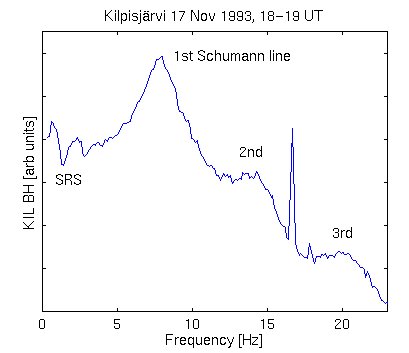 Schumann resonance
Schumann resonance Schumann resonance
Schumann resonancespaceweb@oulu.fi - last update: 13 November 1998, 1140 UT (RR)
 Between the nearly perfectly conducting terrestrial surface and ionosphere, a resonating cavity is formed. Broadband
electromagnetic impulses, like those from lightning flashes, fill this cavity, and create
globally the so-called Schumann resonances at frequencies 5 - 50 Hz
(Schumann, 1952; Bliokh et al., 1980; Sentman, 1987).
The nominal average frequencies observed are 7.8, 14, 20, 26, 33, 39, and
45 Hz with slight diurnal variation (the three first lines can be seen in the figure
displaying data from northern Finland, the Kilpisjärvi station).
It has been suggested that the intensity of these lines could be used to monitor
the global lightning activity, especially after the local time modulation by
changes in D region height has been removed (e.g., Sentman and Fraser, 1991).
Between the nearly perfectly conducting terrestrial surface and ionosphere, a resonating cavity is formed. Broadband
electromagnetic impulses, like those from lightning flashes, fill this cavity, and create
globally the so-called Schumann resonances at frequencies 5 - 50 Hz
(Schumann, 1952; Bliokh et al., 1980; Sentman, 1987).
The nominal average frequencies observed are 7.8, 14, 20, 26, 33, 39, and
45 Hz with slight diurnal variation (the three first lines can be seen in the figure
displaying data from northern Finland, the Kilpisjärvi station).
It has been suggested that the intensity of these lines could be used to monitor
the global lightning activity, especially after the local time modulation by
changes in D region height has been removed (e.g., Sentman and Fraser, 1991).
Note that also the ionospheric Alfvén resonator -related spectral resonance structures (SRS) are formed due to the lightnings, and cover partly the same frequency range. In the figure here only the two first SRS lines are clearly visible. Finally, the strong spike in the figure just below 17 Hz is due to the Swedish railroads!
Standard magnetometers are not able to measure the Schumann resonances, and even the search coil (i.e., pulsation) magnetometers are most often sampled at about 0.1 Hz that does not allow such studies. Special equipment are thus needed (see, e.g., Sentman and Fraser, 1991). That is also true if one wants to study lightning activity with Schumann resonances in other planetary systems: this might work at least for Venus and Jupiter!See also